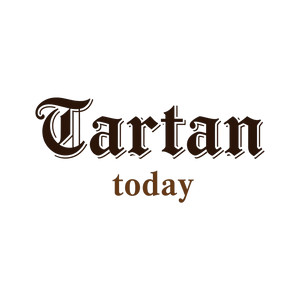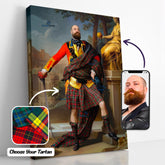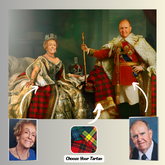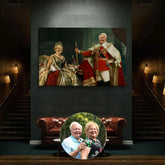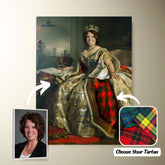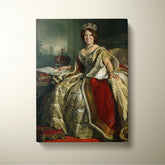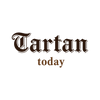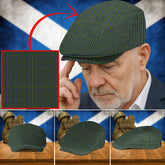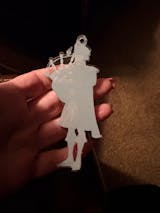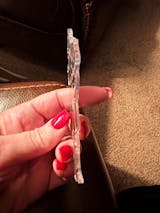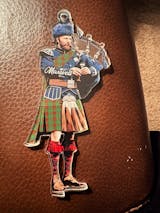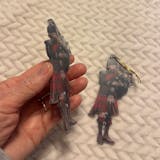-
Personalized Clan Campbell Ancient Tartan Bagpipe Ornament with Custom Name – Scottish Christmas Tree Decoration CD22
Personalized Clan Campbell Ancient Tartan Bagpipe Ornament with Custom Name – Scottish Christmas Tree Decoration CD22Celebrate your Scottish heritage with this unique wood & acrylic tartan ornament. Perfect as a personalized Christmas decoration or a meaningful gift for friends and relatives on special occasions...- From $19.99 USD
$25.99 USD- From $19.99 USD
- Unit price
- per
Save $6.00 -
Personalized Clan Campbell Argyll Ancient Tartan Bagpipe Ornament with Custom Name – Scottish Christmas Tree Decoration QH61
Personalized Clan Campbell Argyll Ancient Tartan Bagpipe Ornament with Custom Name – Scottish Christmas Tree Decoration QH61Celebrate your Scottish heritage with this unique wood & acrylic tartan ornament. Perfect as a personalized Christmas decoration or a meaningful gift for friends and relatives on special...- From $19.99 USD
$25.99 USD- From $19.99 USD
- Unit price
- per
Save $6.00 -
Personalized Clan Campbell Tartan Bagpipe Ornament with Custom Name – Scottish Christmas Tree Decoration HD72
Personalized Clan Campbell Tartan Bagpipe Ornament with Custom Name – Scottish Christmas Tree Decoration HD72Celebrate your Scottish heritage with this unique wood & acrylic tartan ornament. Perfect as a personalized Christmas decoration or a meaningful gift for friends and relatives on special occasions such...- From $19.99 USD
$25.99 USD- From $19.99 USD
- Unit price
- per
Save $6.00 -
Personalized Clan Campbell Modern Tartan Bagpipe Ornament with Custom Name – Scottish Christmas Tree Decoration NM29
Personalized Clan Campbell Modern Tartan Bagpipe Ornament with Custom Name – Scottish Christmas Tree Decoration NM29Celebrate your Scottish heritage with this unique wood & acrylic tartan ornament. Perfect as a personalized Christmas decoration or a meaningful gift for friends and relatives on special occasions...- From $19.99 USD
$25.99 USD- From $19.99 USD
- Unit price
- per
Save $6.00 -
Clan Campbell Of Argyll Family Tartan 2D T-shirt YY51 - Black
Campbell Of Argyll Family Tartan Clan 2D T-shirt YY51 Product detail: This new 2D t-shirt features a relaxed fit for Men and Women, durable, breathable and soft Made from 100% cotton The High-resolution graphic artwork is printed on the entire shirt. Machine wash cold....- $29.25 USD
- $29.25 USD
- Unit price
- per
-
Black
-
White
-
Navy
-
Storm Grey
-
Clan Campbell Argyll Ancient Tartan Christmas Ceramic Ornament Highland Cows Style VO59 - Campbell Argyll Ancient Tartan
Clan Campbell Argyll Ancient Tartan Christmas Ceramic Ornament Highland Cows Style VO59 Product Detail:One of the best things about Christmas is that it gives you an excuse to dress up your home with all of the lovely ornaments we associate with the holiday season....- From $14.45 USD
- From $14.45 USD
- Unit price
- per
-
Campbell Argyll Ancient Tartan
-
Personalized Clan Campbell Argyll Ancient Tartan Drummer Ornament with Custom Name – Scottish Christmas Tree Decoration AY57
Personalized Clan Campbell Argyll Ancient Tartan Drummer Ornament with Custom Name – Scottish Christmas Tree Decoration AY57Celebrate your Scottish heritage with this unique wood & acrylic tartan ornament. Perfect as a personalized Christmas decoration or a meaningful gift for friends and relatives on special...- From $19.99 USD
$25.99 USD- From $19.99 USD
- Unit price
- per
Save $6.00 -
Personalized Clan Campbell Dress Tartan Bagpipe Ornament with Custom Name – Scottish Christmas Tree Decoration GC30
Personalized Clan Campbell Dress Tartan Bagpipe Ornament with Custom Name – Scottish Christmas Tree Decoration GC30Celebrate your Scottish heritage with this unique wood & acrylic tartan ornament. Perfect as a personalized Christmas decoration or a meaningful gift for friends and relatives on special occasions...- From $19.99 USD
$25.99 USD- From $19.99 USD
- Unit price
- per
Save $6.00 -
Campbell of Argyll Modern 2 Tartan Clan Crest Badge Aloha Hawaiian Shirt Tropical Old Style MZ38 - Campbell of Argyll Modern 2 Tartan
Campbell of Argyll Modern 2 Tartan Clan Crest Badge Aloha Hawaiian Shirt Tropical Old Style MZ38 These Hawaiian shirts and shorts are suitable for hot summer days or beach trips with your friends, family, and loved ones. This is an excellent gift, vacation outfit,...- $43.25 USD
- $43.25 USD
- Unit price
- per
-
Campbell of Argyll Modern 2 Tartan
-
Clan Campbell Ancient Tartan Crest Star Ceramic Ornament BY36 - Campbell Ancient Tartan
Clan Campbell Ancient Tartan Crest Star Ceramic Ornament BY36 One of the best things about Christmas is that it gives you an excuse to dress up your home with all of the lovely ornaments we associate with the holiday season. With so many different...- From $19.25 USD
- From $19.25 USD
- Unit price
- per
-
Campbell Ancient Tartan
-
Personalized Clan Campbell Dress Tartan Drummer Ornament with Custom Name – Scottish Christmas Tree Decoration PK77
Personalized Clan Campbell Dress Tartan Drummer Ornament with Custom Name – Scottish Christmas Tree Decoration PK77Celebrate your Scottish heritage with this unique wood & acrylic tartan ornament. Perfect as a personalized Christmas decoration or a meaningful gift for friends and relatives on special occasions...- From $19.99 USD
$25.99 USD- From $19.99 USD
- Unit price
- per
Save $6.00 -
Personalized Clan Campbell Tartan Bagpipe Ornament with Custom Name – Scottish Christmas Tree Decoration NS53
Personalized Clan Campbell Tartan Bagpipe Ornament with Custom Name – Scottish Christmas Tree Decoration NS53Celebrate your Scottish heritage with this unique wood & acrylic tartan ornament. Perfect as a personalized Christmas decoration or a meaningful gift for friends and relatives on special occasions such...- From $19.99 USD
$25.99 USD- From $19.99 USD
- Unit price
- per
Save $6.00 -
Personalized Clan Campbell of Argyle #3 Modern Tartan Bagpipe Ornament with Custom Name – Scottish Christmas Tree Decoration FM79
Personalized Clan Campbell of Argyle #3 Modern Tartan Bagpipe Ornament with Custom Name – Scottish Christmas Tree Decoration FM79Celebrate your Scottish heritage with this unique wood & acrylic tartan ornament. Perfect as a personalized Christmas decoration or a meaningful gift for friends and relatives...- From $19.99 USD
$25.99 USD- From $19.99 USD
- Unit price
- per
Save $6.00 -
Personalized Clan Campbell Argyll Ancient Tartan Bagpipe Ornament with Custom Name – Scottish Christmas Tree Decoration UV42
Personalized Clan Campbell Argyll Ancient Tartan Bagpipe Ornament with Custom Name – Scottish Christmas Tree Decoration UV42Celebrate your Scottish heritage with this unique wood & acrylic tartan ornament. Perfect as a personalized Christmas decoration or a meaningful gift for friends and relatives on special...- From $19.99 USD
$25.99 USD- From $19.99 USD
- Unit price
- per
Save $6.00 -
Personalized Clan Campbell (Simpson) Personal Ancient Tartan Bagpipe Ornament with Custom Name – Scottish Christmas Tree Decoration AN72
Personalized Clan Campbell (Simpson) Personal Ancient Tartan Bagpipe Ornament with Custom Name – Scottish Christmas Tree Decoration AN72Celebrate your Scottish heritage with this unique wood & acrylic tartan ornament. Perfect as a personalized Christmas decoration or a meaningful gift for friends and relatives on...- From $19.99 USD
$25.99 USD- From $19.99 USD
- Unit price
- per
Save $6.00 -
Personalized Clan Campbell Dress Ancient Tartan Bagpipe Ornament with Custom Name – Scottish Christmas Tree Decoration EZ32
Personalized Clan Campbell Dress Ancient Tartan Bagpipe Ornament with Custom Name – Scottish Christmas Tree Decoration EZ32Celebrate your Scottish heritage with this unique wood & acrylic tartan ornament. Perfect as a personalized Christmas decoration or a meaningful gift for friends and relatives on special...- From $19.99 USD
$25.99 USD- From $19.99 USD
- Unit price
- per
Save $6.00 -
Personalized Clan Campbell Argyll Weathered Tartan Bagpipe Ornament with Custom Name – Scottish Christmas Tree Decoration RS95
Personalized Clan Campbell Argyll Weathered Tartan Bagpipe Ornament with Custom Name – Scottish Christmas Tree Decoration RS95Celebrate your Scottish heritage with this unique wood & acrylic tartan ornament. Perfect as a personalized Christmas decoration or a meaningful gift for friends and relatives on special...- From $19.99 USD
$25.99 USD- From $19.99 USD
- Unit price
- per
Save $6.00 -
Clan Campbell Ancient Tartan Flat Cap GV76 - Clan Campbell Ancient Tartan
Clan Campbell Ancient Tartan Flat Cap GV76Elevate Your Heritage: The Authentic Tartan Jeff Cap Step into a legacy of timeless style and comfort with our Authentic Tartan Flat Cap. Crafted for the discerning American who cherishes their Scottish roots and appreciates classic elegance, this isn’t...- From $33.85 USD
$45.59 USD- From $33.85 USD
- Unit price
- per
Save $11.74-
Clan Campbell Ancient Tartan
-
Clan Campbell Tartan Flat Cap UW20 - Clan Campbell Tartan
Clan Campbell Tartan Flat Cap UW20Elevate Your Heritage: The Authentic Tartan Jeff Cap Step into a legacy of timeless style and comfort with our Authentic Tartan Flat Cap. Crafted for the discerning American who cherishes their Scottish roots and appreciates classic elegance, this isn’t just...- From $33.85 USD
$45.59 USD- From $33.85 USD
- Unit price
- per
Save $11.74-
Clan Campbell Tartan
-
Clan Campbell Modern Tartan Flat Cap VF56 - Clan Campbell Modern Tartan
Clan Campbell Modern Tartan Flat Cap VF56Elevate Your Heritage: The Authentic Tartan Jeff Cap Step into a legacy of timeless style and comfort with our Authentic Tartan Flat Cap. Crafted for the discerning American who cherishes their Scottish roots and appreciates classic elegance, this isn’t...- From $33.85 USD
$45.59 USD- From $33.85 USD
- Unit price
- per
Save $11.74-
Clan Campbell Modern Tartan
Ex: Your Tartan + Product
Popular Products
Turn Me Royal Personalized Portrait from Your Photo, Custom Tartan. Custom Canvas Wall Art as Gift for Men
- From $32.45 USD
- From $32.45 USD
- Unit price
- / per
Royalty Couple Personalized Portrait from Your Photo, Custom Tartan. Custom Canvas Wall Art
- From $47.45 USD
- From $47.45 USD
- Unit price
- / per
The Queen Personalized Portrait from Your Photo, Custom Tartan. Custom Canvas Wall Art as Gift for Women
- From $32.45 USD
- From $32.45 USD
- Unit price
- / per
Which Clan Are You From?
- Apron
- Argyle Campbell Ancient
- Argyle Campbell Modern
- Argyle Campbell Reproduction
- Calder
- Calder (Calder-Campbell)
- Calder (Calder-Campbell) Tartan
- Campbell
- Campbell (Brown) Personal Ancient
- Campbell (Brown) Personal Modern
- Campbell (Brown) Personal Reproduction
- Campbell (Simpson) Personal #2 Ancient
- Campbell (Simpson) Personal #2 Modern
- Campbell (Simpson) Personal #2 Reproduction
- Campbell (Simpson) Personal Ancient
- Campbell (Simpson) Personal Modern
- Campbell (Simpson) Personal Reproduction
- Campbell 42nd Dress Ancient
- Campbell 42nd Dress Balhousie Weathered
- Campbell 42nd Dress Weathered
- Campbell 42nd; Dress Ancient
- Campbell 42nd; Dress Modern
- Campbell 42nd; Dress Reproduction
- Campbell 42nd; Dress; Balhousie Ancient
- Campbell 42nd; Dress; Balhousie Modern
- Campbell 42nd; Dress; Balhousie Reproduction
- Campbell Ancient
- Campbell Ancient 01
- Campbell Ancient 01 Tartan
- Campbell Ancient 02
- Campbell Ancient 02 Tartan
- Campbell Ancient 2
- Campbell Ancient Gnome
- Campbell Ancient Tartan
- Campbell Argyll Ancient
- Campbell Argyll Ancient Tartan
- Campbell Argyll Modern
- Campbell Argyll Modern Tartan
- Campbell Argyll Weathered
- Campbell Argyll Weathered Tartan
- Campbell Camel Ancient
- Campbell Camel Modern
- Campbell Camel Reproduction
- Campbell Camel Weathered
- Campbell clanCampbell tartanPillow Cover
- Campbell Dress
- Campbell Dress #2 Ancient
- Campbell Dress #2 Modern
- Campbell Dress #2 Reproduction
- Campbell Dress 01
- Campbell Dress 02
- Campbell Dress 2 Weathered
- Campbell Dress Ancient
- Campbell Dress Ancient Tartan
- Campbell Dress Modern
- Campbell Dress Reproduction
- Campbell Dress Tartan
- Campbell Dress; 1880 variant Ancient
- Campbell Dress; 1880 variant Modern
- Campbell Dress; 1880 variant Reproduction
- Campbell Faded
- Campbell Faded Tartan
- Campbell Hebridean Modern
- Campbell Hunting Ancient
- Campbell Hunting Modern
- Campbell Hunting Reproduction
- Campbell Hunting Weathered
- Campbell Marquis of Lorne Ancient
- Campbell Marquis of Lorne Ancient 2
- Campbell Marquis of Lorne Modern
- Campbell Marquis of Lorne Modern 2
- Campbell Marquis of Lorne Reproduction
- Campbell Marquis of Lorne Weathered
- Campbell Marquis of Lorne Weathered 2
- Campbell Modern
- Campbell Modern 2
- Campbell Modern Tartan
- Campbell Muted
- Campbell of Argyle #3 Ancient
- Campbell of Argyle #3 Modern
- Campbell of Argyle #3 Reproduction
- Campbell of Argyle #4 Ancient
- Campbell of Argyle #4 Modern
- Campbell of Argyle #4 Reproduction
- Campbell of Argyle Black guards Ancient
- Campbell of Argyle Black guards Modern
- Campbell of Argyle Black guards Reproduction
- Campbell Of Argyll
- Campbell of Argyll (No Guards)
- Campbell Of Argyll 01
- Campbell Of Argyll 02
- Campbell of Argyll 03
- Campbell of Argyll 1815 Ancient
- Campbell of Argyll 1815 Ancient 2
- Campbell of Argyll 1815 Modern
- Campbell of Argyll 1815 Modern 2
- Campbell of Argyll 1815 variant Ancient
- Campbell of Argyll 1815 variant Modern
- Campbell of Argyll 1815 variant Reproduction
- Campbell of Argyll 1815 Weathered
- Campbell of Argyll 1815 Weathered 2
- Campbell of Argyll Ancient
- Campbell of Argyll Modern
- Campbell of Argyll Modern 2
- Campbell of Argyll Muted
- Campbell of Argyll no guards Ancient
- Campbell of Argyll no guards Modern
- Campbell of Argyll no guards Reproduction
- Campbell of Argyll Reproduction
- Campbell of Argyll Weathered
- Campbell of Argyll Weathered 2
- Campbell of Armaddie
- Campbell of Armaddie Ancient
- Campbell of Armaddie Modern
- Campbell of Armaddie Reproduction
- Campbell of Braemar Ancient
- Campbell of Braemar Modern
- Campbell of Braemar Reproduction
- Campbell of Glenlyon Ancient
- Campbell of Glenlyon Ancient 2
- Campbell of Glenlyon Modern
- Campbell of Glenlyon Modern 2
- Campbell of Glenlyon Reproduction
- Campbell of Glenlyon Weathered
- Campbell of Glenlyon Weathered 2
- Campbell of Inveraray Ancient
- Campbell of Inveraray Ancient 2
- Campbell of Inveraray Modern
- Campbell of Inveraray Modern 2
- Campbell of Inveraray Reproduction
- Campbell of Inveraray Weathered
- Campbell of Inveraray Weathered 2
- Campbell of Lochawe Ancient
- Campbell of Lochawe Modern
- Campbell of Lochawe Modern 2
- Campbell of Lochawe Reproduction
- Campbell of Lochawe Weathered
- Campbell of Lochawe Weathered 2
- Campbell of Lochlane Ancient
- Campbell of Lochlane Ancient 2
- Campbell of Lochlane Modern
- Campbell of Lochlane Modern 2
- Campbell of Lochlane Reproduction
- Campbell of Lochlane Weathered
- Campbell of Lochnell Dress
- Campbell Of Loudon
- Campbell of Loudon (Campbell Louden) Ancient
- Campbell of Loudon (Campbell Louden) Ancient 2
- Campbell of Loudon (Campbell Louden) Modern
- Campbell of Loudon (Campbell Louden) Modern 2
- Campbell of Loudon (Campbell Louden) Weathered
- Campbell of Loudon (Campbell Louden) Weathered 2
- Campbell of Loudon Ancient
- Campbell of Loudon Modern
- Campbell of Loudon Plaid Ancient
- Campbell of Loudon Plaid Ancient 2
- Campbell of Loudon Plaid Modern
- Campbell of Loudon Plaid Modern 2
- Campbell of Loudon Plaid Reproduction
- Campbell of Loudon Plaid Weathered
- Campbell of Loudon Plaid Weathered 2
- Campbell of Loudon Reproduction
- Campbell of Loudon; New Ancient
- Campbell of Loudon; New Modern
- Campbell of Loudon; New Reproduction
- Campbell of Loudoun
- Campbell Old Ancient
- Campbell Red
- Campbell Red Ancient
- Campbell Red Modern
- Campbell Red Muted
- Campbell Red Reproduction
- Campbell Reproduction
- Campbell Tartan
- Campbell The 42nd Ancient
- Campbell The 42nd Modern
- Campbell The 42nd Reproduction
- Campbell The 42nd Weathered
- Campbell Weathered
- Campbell Weathered 2
- Carter - Campbell of Possil
- Scott
- Stewart Campbell Ancient
- Stewart Campbell Modern
- Stewart Campbell Reproduction
List Of Tartan
-
Clan A
- Abercrombie Tartan
- Aberdeen Tartan
- Abernethy Tartan
- Adair Tartan
- Adam Tartan
- Ayrshire Tartan
- Agnew Tartan
- Aikenhead Tartan
- Ainslie Tartan
- Aiton Tartan
- Allan Tartan
- Alexander Tartan
- Allardice Tartan
- Allison Tartan
- Anderson Tartan
- Angus Tartan
- Anstruther Tartan
- Arbuthnot Tartan
- Armstrong Tartan
- Arnott Tartan
- Auchinleck Tartan
- Ayrshire Tartan
-
Clan B
- Baillie Tartan
- Bain Tartan
- Baird Tartan
- Balfour Tartan
- Bannatyne Tartan
- Bannerman Tartan
- Barclay Tartan
- Baxter Tartan
- Beaton Tartan
- Bell Tartan
- Belshes Tartan
- Bethune Tartan
- Beveridge Tartan
- Binning Tartan
- Bisset Tartan
- Blackadder Tartan
- Blackstock Tartan
- Black Watch Tartan
- Blair Tartan
- Blane Tartan
- Blyth Tartan
- Borthwick Tartan
- Boswell Tartan
- Bowie Tartan
- Boyd Tartan
- Boyle Tartan
- Brisbane Tartan
- Brodie Tartan
- Brown/ Broun Tartan
- Bruce Tartan
- Buccleuch Tartan
- Buchan Tartan
- Buchanan Tartan
- Burnett Tartan
- Burns Tartan
- Butter Tartan
- Byres Tartan
-
Clan C
- Cairns Tartan
- Calder Tartan
- Callander Tartan
- Cameron Tartan
- Campbell Tartan
- Campbell of Breadalbane Tartan
- Campbell of Cawdor Tartan
- Carmichael Tartan
- Carnegie Tartan
- Carruthers Tartan
- Cathcart Tartan
- Chalmers Tartan
- Charteris Tartan
- Chattan Tartan
- Cheyne Tartan
- Chisholm Tartan
- Christie Tartan
- Clark Tartan
- Clelland Tartan
- Clephan Tartan
- Clergy Tartan
- Cochrane Tartan
- Cockburn Tartan
- Colquhoun Tartan
- Colville Tartan
- Cooper Tartan
- Couper Tartan
- Craig Tartan
- Cranstoun Tartan
- Crawford Tartan
- Crichton Tartan
- Crief District Tartan
- Crosbie Tartan
- Cumming Tartan
- Cunningham Tartan
- Currie Tartan
- Clan D
- Clan E
- Clan F
- Clan G
- Clan H
- Clan I
- Clan J
- Clan K
- Clan L
-
Clan M
- Maitland Tartan
- Malcolm Tartan
- Mar Tartan
- Marjoribanks Tartan
- Maxtone Tartan
- Matheson Tartan
- Maule Tartan
- Maxwell Tartan
- Meldrum Tartan
- Melville Tartan
- Menzies Tartan
- Mercer Tartan
- Middleton Tartan
- Moffat Tartan
- Moncrieffe Tartan
- Montgomery Tartan
- Monypenny Tartan
- Moncreiffe Tartan
- Monteith Tartan
- Morrison Tartan
- Mouat Tartan
- Moubray Tartan
- Mow Tartan
- Muir_More Tartan
- Muirhead Tartan
- Munro Tartan
- Murray Tartan
- Murray of Atholl Tartan
-
Clan Mc/Mac
- MacAlister Tartan
- MacArthur Tartan
- MacAlpine Tartan
- MacAulay Tartan
- MacBain Tartan
- MacBean Tartan
- MacBeth Tartan
- MacCallum Tartan
- MacCraig Tartan
- MacColl Tartan
- MacCorquodale Tartan
- MacDiarmid Tartan
- MacDonald Tartan
- MacDonald of Clanranald Tartan
- MacDonald of Sleat Tartan
- MacDonnell of Glengarry Tartan
- MacDonnell of Keppoch Tartan
- MacDougall Tartan
- MacDowall Tartan
- MacDuff Tartan
- MacEwen_MacEwan Tartan
- MacEdward Tartan
- MacFarlane Tartan
- MacGill Tartan
- MacGillivray Tartan
- MacGregor Tartan
- MacGowan (McGowan) Tartan
- MacHardy Tartan
- MacIan Tartan
- MacInnes Tartan
- MacIntyre Tartan
- MacKay Tartan
- MacKillop Tartan
- MacKellar Tartan
- Mackinlay Tartan
- MacKenzie Tartan
- Mackie Tartan
- MacKinnon Tartan
- MacKintosh / MacIntosh Tartan
- MacLeod Tartan
- MacMillan Tartan
- MacNab Tartan
- MacNaughton Tartan
- MacNeil / MacNeill Tartan
- MacNeil of Colonsay Tartan
- MacNicol Tartan
- MacPhail Tartan
- MacPhee_MacFie Tartan
- MacPherson Tartan
- MacQuarrie Tartan
- MacQueen Tartan
- MacRae Tartan
- MacRow Tartan
- MacSporran Tartan
- MacTaggart Tartan
- MacTavish Tartan
- MacThomas Tartan
- McCorquodale Tartan
- McCulloch Tartan
- McFadzen Tartan
- McGeachie Tartan
- McIver Tartan
- McKerrell Tartan
- Clan N
- Clan O
- Clan P
- Clan R
-
Clan S
- Sandilands Tartan
- Scott Tartan
- Scrymgeour Tartan
- Selkirk Tartan
- Sempill Tartan
- Seton Tartan
- Shaw Tartan
- Shepherd Tartan
- Sinclair Tartan
- Skene Tartan
- Skirving Tartan
- Smith Tartan
- Somerville Tartan
- Spalding Tartan
- Spens Tartan
- Spottiswood Tartan
- Stevenson Tartan
- Stewart Tartan
- Stewart of Appin Tartan
- Stirling Tartan
- Strachan Tartan
- Straiton Tartan
- Strange Tartan
- Strathclyde District Tartan
- Stuart of Bute Tartan
- Sutherland Tartan
- Swinton Tartan
- Clan T
- Clan U W Y
- Request Your Clan
Clan Campbell (Campbell Tartan)
1. About Clan Campbell (Campbell Tartan)
2. Clan Campbell History (Campbell Tartan)
The first Cambell ancestor is said to have appeared in the eleventh or twelfth century. He was Smevie or Mervvn, the son of Arthur, also known as "the Wildman of the Woods." Probably given as a nickname to recognize his prowess as a hunter.
Some claim he was the legendary Arthur's son. There is no proof to support this claim. It took several generations before Campbell became popular.
Inveraray Castle in Argyll is the seat of the Duke of Argyll, chief of Clan Campbell, and has been since the 1600s
The Campbells' ancestry is multiracial, like that of the majority of Scots. The Campbells have a long and distinguished history. From the 16th through the 18th century, they were among the most influential families in Perthshire and Argyll.
The Chiefs of Clan Campbell have had significant positions within the Scottish government for more than 450 years, starting in 1457.
Many Campbells are descended from the Dalriadic O'Duibne, a group of Scots-Gaelic people who lived in Lochawe in the 13th century and were based there.
The Campbell family is also thought to be descended from the Strathclyde Britonic Celts, sometimes known as the "Romano British". The early "Kingdom of Strathclyde"'s northwestern region is where the Britonic Celts originated.
Aberdeenshire and the county of Argyll are to the northeast of Scotland; it is in this county that the Cambell dynasty attained prominence.
With inhabited islands and more than 1000 miles of shoreline, Argyll spans a vast territory that is roughly 100 miles long and a little less wide.
2.1 FIRST CAMPBELL ANCESTORS
According to legend, the first of the Cambell ancestors (then known as Campbell) arrived in Argyll and wed Eva, the daughter of Paul a Sporran, the O'Duibne tribe's heiress. They resided close to Lochawe.
The name Cambel (as it was originally spelled) first appeared in a record of a landowner near Stirling in 1263. The first records for a Cambel in Argyll originate from 1293 for Duncan Dubh, a landowner from Kintyre. Sir Cailein (Great Colin) of Lochawe was killed after being attacked by Clan Dougall, according to written records for Cambels in Lochawe dating back to 1296.
The Cambels of Lochawe were strongly established in the region, and at the time Sir Thomas of Kintyre and Sir Duncan Dubh were at least two additional Cambels who owned territory in Argyll.
2.2 THE NAME CAMBELL
The title of Lord Cambell in Lochawe in 1445 marked the first official use of the name Cambell. Dugald on Lochawe, Sir Sir Cailein Mor Campbell's ancestor, first earned the moniker "Cam Beul" for allegedly speaking out of one side of his mouth.
Gaelic for "curved mouth" is "cam beul." Because Duncan's family loved him so much, they continued to refer to themselves by his moniker.
The fact that the Earl of Orknet, who passed away in 1020, was also known as "Einar Wry-Mouth" is an intriguing "coincidence." One explanation might be the medical term for the condition, "torticollis," which means "twisted neck" in Latin.
This disease results in a 'Cam beul' or curved mouth, with the chin and mouth turned to the opposite side and the head tilted to one side.
The family name, or surname, was originally spelled Cambel. This didn't change to be spelled Campbell until King David, the son of Robert the Bruce, ascended to the throne as King of Scotland.
While in power, King David dispatched a number of Norman knights in an effort to implement Norman efficiency in government.
The spelling of "Campbell" from "Cambel" was more likely the outcome of this than it was the result of Gaelic scribes trying to write the Gaelic name.
3. Clan Campbell Tartans
The Campbell tartan, also known as the historic Black Watch, may have been worn by the Campbells earlier than the dates when it was allegedly designated for the Highland Companies in 1725 and the Black Watch in 1739.
However, troops were required to don the same colors, but necessarily the same sett, when the initial Highland companies were founded. Later on, this would have been standardized.
The question of whether the Black Watch or the Campbell appeared first during the Victorian era was hotly contested, and it has never been settled.
While "modern" refers to the employment of darker colors, "ancient" refers to the dye colours, which are typically lighter.
The term "weathered" describes a dye that attempts to imitate a tartan fragment purportedly discovered in the 1950s near the site of a historic battle.
Thread count G24 K6 G24 K20 B24 K4 B/4 B/24 K4 B4 K4 B4 K20
Campbell Ancient
Campbell Modern
Campbell Weathered
The garment Campbell tartan first appeared in 1880's Clans Originaux, a book of tartan patterns published by J Claude Freres et Cie of Paris. Nevertheless, the 12th Duke refused to recognize it as a Campbell tartan.
According to legend, Queen Victoria thought tartans were too dull for women and added a white background, which led to the creation of dress tartans. Although it's a charming tale, who knows.
While "modern" refers to the employment of darker colors, "ancient" refers to the dye colours, which are typically lighter.
Campbell Dress Ancient
Campbell Dress Modern
The Cockburn collection first listed the Campbell of Argyll tartan in 1815.
This tartan did not impress the chief of Clan Campbell, who declared, "Let me get rid of the idea that there is a 'Campbell of Argyll' [tartan] once and for all." Even though it is true that the Sixth Duke [of Argyll] added a white line to his plain Campbell tartan to set himself apart from the other Campbells (he being the chief and entitled to do so), he was the only member of the family to do so, and the other members of the family thought he was being rather pompous by doing it.
The tartan is asymmetrical.
While "modern" refers to the employment of darker colors, "ancient" refers to the dye colours, which are typically lighter.
The term "weathered" describes a dye that attempts to imitate a tartan fragment purportedly discovered in the 1950s near the site of a historic battle.
Campbell of Argyll Ancient
Campbell of Argyll Modern
Campbell of Argyll Weathered
'Breadalbane' is the name given to the Campbell of Breadalbane tartan when it first appears in the Cockburn collection between 1810 and 1820. Sir William Cockburn gathered this tartan, one of the first collections ever.
Given that it is supposed to have been replicated from a plaid that belonged to the Captain of Dunstaffnage in Dunstfanage around 1750, it may perhaps be older.
While "modern" refers to the employment of darker colors, "ancient" refers to the dye colours, which are typically lighter.
Y4 G18 K/18 Threadcound K/6 B18 K18 G18
Campbell of Breadalbane Ancient
Campbell of Breadalbane Modern
4. Clan Campbell Crest & Coats of Arms
4.1 Clan Campbell Crest
Worn by all of the name and ancestry
5. Clan Campbell Coat of Arms
Note on Coats of Arms: A coat of arms is given to an individual under Scottish heraldic law (with the exception of civic or corporate arms). A 'family coat of arms' does not exist.
With the exclusions listed above, the weapons depicted below are personal weapons. The only person authorized to use these weapons is the grantee.
Arms of Ian Campbell 12th Duke of Argyll
EARL OF ARGYLE
Quarterly 1st & 4th gyronny of eight Or and Sable 2nd & 3rd Argent a galley oars in action Sable. 1672-7
CAMPBELL OF LOCHNELL
First and fourth gyronny of eight, quarterly, Or and Sable Third: Argent, a galley oar in motion Sable; second: Azure, a boar's head couped Or. Second matriculation of the Ordinary of Arms, 1808; third matriculation of the Campbell of Airds Armorial, 2002
EARL OF CAWDOR
Quarterly, Or a hart's head caboshed Sable attired Gules, Gyronny of eight Or and Sable, galley Sable, Argent, and cross Or split per fess of Azure and Gules. Second matriculation of the Ordinary of Arms in 1722
CAMPBELL OF AIRDS
first gyronny of eight, quarterly, Or and Sable A stag's head caboshed in Sable and clad in Gules, 2nd Or 3rd Or, a galley sail and saltire-shaped oars. Sable Fourth Or a fess check All of Azure and Argent are enclosed by a border of Gules. Volume II of the Ordinary of Arms, 1964
BURNLEY-CAMPBELL OF ORMIDALE
A ship in full sail, Proper, on a chief engrailed Azure, a cornucopia between two bees volant, also Proper, quarterly 1st & 4th gyronny of eight Ermine and Sable 2nd & 3rd Ermine. 1895 Ordinary of Arms
EARL OF BREADALBANE
Quarterly 1st & 4th gyronny of eight Or and Sable, 2nd Argent a galley (CAMPBELL OF GLENORCHY). Sable, third, Or, a fess crosslet of Azure and Argent. 1672–1707 Ordinary of Arms
CAMPBELL OF ARDKINGLAS
Ordinary of Arms, 1672–1701. Gyronny of eight Sable and Or within a bordure of Or.
CAMPBELL OF BALGIRSHO
Gyronny of eight Ermine and Gules, within an encircling bordure of eight Argent crescents. 1672–1707 Ordinary of Arms
Ian Murray CAMPBELL UE
Canada Quarterly, first and fourth gyronny of eight, Or and Sable, second Argent, a lymphad. Third Or a fess chequy, sable oars in motion Argent and Azure are all combined inside a pale dexter bordure. Three mullets are charged by a Vair sinister Azure. 1984's Campbell of Airds Armorial
CAMPBELL OF INVERAWE
According to CAMPBELL OF AUCHENDARROCH's representation Gyronny of eight Or and Sable with a wavy Azure border and six salmon rising on the proper side. Volume II of the Ordinary of Arms, 1908
Diarmid Alexander CAMPBELL
A martlet Argent in the point within a wavy per pale Azure and Or bordure is charged with six salmon naiant Proper on a gyronny of eight Or and Sable. Airds Armorial, Campbell of, 1974
EARL OF LOUDOUN
Gyronny of eight Ermine and Gules. Ordinary of Arms, 1672-7
LORD CAMPBELL OF CROY
Gyronny of eight Or and Sable, two pheons pointing up in Gules, on a fess of Ermine. 1980's Campbell of Airds Armorial
Donald Draper CAMPBELL
USA The first is a Gyronny of eight Or and Sable, charged with four ibis heads within an Azure bordure. 1984's Campbell of Airds Armorial
Danny Byrd CAMPBELL
USA Campbell of Airds Armorial, 1999. Gyronny of eight Or and Sable on a fess engrailed Argent charged with three piles rising from the base Azure.
Theodore Emerson CAMPBELL
USA Gyronny of eight Or and Sable with an Argent crescent between two Or robes on a Vert fess. 2009's The Court of the Lord Lyon
John MACKINNON-CAMPBELL
Quarterly, first and fourth gyronny of eight Or and Sable on canton Argent a pineapple proper, second and third Argent a buck pursued by a greyhound proper to the dexter over a field in base Vert within a bordure Azure. 1806 College of Arms
Guy Edward Spencer CAMPBELL
Second and third Argent goutty de poix on a fess engrailed three towers of the field, quarterly first and fourth gyronny of eight Or and sable. 1924 College of Arms
Archibald Mitchell CAMPBELL
Gyronny of eight Gules and Ermine with a chief Azure, two garbs Or, and a pale Or charged with a lymphad sail furled in action on a Sable background and flying pennons of the first. 1957 College of Arms
Brian Pierre De Villiers CAMPBELL
Indigo a lymphad Oars in Sable, sail in Or, flags and pennants flying to dexter Gules, all enclosed in an Or and Sable border. Bureau of Heraldry for South Africa, 1984
Gordon Muir CAMPBELL MLA
A fess wavy Argent is charged with a bar gemel wavy Azure on a gyronny of eight Or and Gules. 2007, Canadian Heraldic Authority
Laura Dent Campbell
Bachelor of Arts in Political Science, Psychology, and Environmental Studies
Gyronny of eight Or and Sable, the First within an Azure bordure charged with three fleur-de-lys Or for distinction, the Second within a bordure charged with four glossy ibises' heads erased. Above the shield is a helmet appropriate for her degree, with a Mantling Sable doubled Or, a glossy ibis Sable set for Crest on a Wreath of the Liveries, and this Motto "IN HARMONY" in an Escrol above the same.
Matriculated: Lord Lyon issues an interlocutor to Lyon Clerk September 30, 2013
Donald Draper Campbell, the North American Delegate to the Society, is the father of Laura. Look at that entry.
John Hamilton Gaylor drew his sword
George Willard Campbell, B.S.M.E, P.E, LtCol USAFR (ret)
Arms: gyronny of eight Or and Sable, the first charged with four ibises’ heads erased of the second, within a bordure Azure
Crest: an ibis Sable
Motto: IN HARMONY
Matriculated: The Court of the Lord Lyon, 20th February 1984. Lyon Register, vol. 65, folios 88 & 89
Donald Draper Campbell, B.S.E.E., FSA Scot.
Arms: gyronny of eight Or and Sable, the first charged with four ibises’ heads erased of the second, within a bordure Azure.
Crest: an ibis Sable
Motto: IN HARMONY
Matriculated: The Court of the Lord Lyon, 20th February 1984. Lyon Register, vol. 65, folios 88 & 89
Thomes Walker Campbell B.F.A. (Hon)
Arms: gyronny of eight Or and Sable, the first charged with four ibises’ heads erased of the second, within a bordure Azure (borne during the lifetime of his father debruised of a three point label Azure)
Crest: an ibis Sable
Motto: IN HARMONY
Matriculated: The Lord Lyon's Court on February 20, 1984. Folios 88 and 89 of Lyon Register, volume 65.
Son of Donald Draper Campbell, the North American representative of the Society. look at that entry
5. Clan Campbell Places & People
5.1 Clan Campbell Places
The Innis Chonnell family had lived in a fortified fortress that spanned the entire island of Loch Awe. The peaks of Cruachan Beann, the hills from which the Campbells drew their war cry, rise behind it.
On Innis Chonnell, the ruins of the castle are still discernible among the trees. It served as Sir Colin Campbell's home and the Campbell family's first stronghold until it was abandoned in the fifteenth century.
Sir Colin Campbell was killed at The Battle of Red Ford.
The Glowm estate in Clackmannanshire, subsequently known as Castle Campbell, was bought by the 1st Earl of Argyll and served as the Campbell family's seat in the Lowlands from the 15th to the 19th centuries.
The Earl's requirement to appear in court was satisfied by the position of Glown (Castle Campbell).
The MacDonalds, Lords of the Isles, were the 1st Earl of Argyll's longtime adversaries, and he played a key role in their downfall.
King James V visited the castle at Inveraray in 1533, therefore it has existed on these lands at least since the 15th century.
The previous fortification was replaced by the current Inveraray Castle, which was constructed between 1743 and 1746. One of the first instances of Gothic Revival architecture in existence is seen in the castle.
The 13th Duke of Argyll, Torquhil Campbell, resides at Inveraray Castle, which has served as the family seat of the Campbell Dukes of Argyll since the 18th century.
5.2 Clan Campbell People
5.2.1 Sir Henry Campbell–Bannerman (1836-1908)
The future Lord Provost was the father of the Prime Minister of Great Britain from 1905 to 1908, who was born in Glasgow.
He hyphenated the names of his mother and father in order to inherit the wealth of a deceased uncle.
Before serving as Stirling's liberal MP for the remainder of his life, he attended Glasgow and Cambridge for his academic training.
Throughout his career, he served in a variety of ministerial capacities. In 1895, he was awarded a knighthood. He was characterized as a fierce combatant who supported the suffragette cause and the Boers' right to self-government.
When he was prime minister, his cabinet included Henry Herbert Asquith, Lloyd George, and Winston Churchill. However, when his health declined, he was forced to withdraw from politics and passed away within a fortnight.
5.2.2 Sir Colin Campbell, Lord Clyde (1792-1863) - pictured top
According to a legend, Colin MacIver adopted his mother's maiden name after hearing the Duke of York recommend Campbell as a name for a soldier.
The Glasgow carpenter's son, Colin Campbell, advanced through the British Army's ranks and was given the title of Field Marshall in 1862.
He distinguished himself in battle in China, the West Indies, India, and the Crimea, where he led the Highland Brigade to victory in the Battle of Alma before continuing the fight against the Russian Cavalry at Balaclava with "the Thin Red Line." He is remembered as a military titan of the British Empire in the middle of the 19th century, and his remains is interred at Westminster Abbey.
5.2.3 Sir Malcolm Brown Campbell (1848-1935)
The famed Malcolm Campbell grocery chain's founder experienced a journey from poverty to affluence.
He tried to bring the world's products to the high street from the time of his birth in Kilwinning, Ayrshire, and while doing errands for a greengrocer in Glasgow, developing fruit and vegetable sales.
He was the person who introduced bananas to Scotland. His choice of railroad stations as potential locations for his kiosks played a significant role in his success. His accomplishments led to his knighthood in 1922.
5.2.4 Angus Campbell (1903-82)
Angus Campbell, also known as Am Puilean, was a poet and author who was raised in the Isle of Lewis settlement of Ness.
He was a prisoner of war in Poland during World War II. His book of Gaelic poetry, titled "Chaff & Wheat," was published in 1972. His autobiography, "Touching Many Headlands," was released the year after.
6. Associated Names
Considered septs or linked names of Clan Campbell are the following:
ARTHUR, MACARTAIR, MACARTHUR, MACCARTER, BANNATYNE, BURNES, BURNESS, BURNETT, BURNS, CADDELL, CADELL, CALDER, CATTELL, CONNOCHIE, CONOCHIE, MACCONACHIE, MACCONCHIE, MACCONNECHY, MACCONOCHIE, DENOON, DENUNE, GIBBON, GIBSON, KELLAR, KELLER, MACELLER, MACKELLAR, LORNE, LOUDEN, LOUDON, LOUDOUN, LOWDEN, LOWDON, MACGIBBON, MACGUBBIN, HARRES, HARRIS, HAWES, HAWS, HAWSON, HASTINGS, ISAAC, ISAACS, KISSACK, KISSOCK, MACISAAC, MACKESSACK, MACKESSOCK, MACKISSOCK, IVERSON, MACEVER, MACGURE, MACIVER, MACIVOR, MACURE, MACCOLM, MACCOLMBE, MACLAWS, MACLEHOSE, MACTAUSE, MACTAVISH, MACTHOMAS, MACDERMID, MACDERMOTT, MACDIARMID, MACELVIE , MACKELVIE, MACGLASRICH , MACKERLIE , MACNICHOL , MACNOCAIRD, MACORAN, MACOWEN, MACPHEDRAN, MACPHUN, MOORE, MUIR, OCHILTREE, PINKERTON, TORRIE, TORRY, TAWESON, TAWESSON, THOMAS, THOMASON, THOMPSON, THOMSON, ORR, URE
- Choosing a selection results in a full page refresh.
